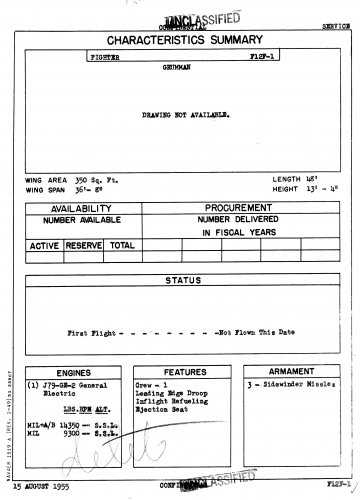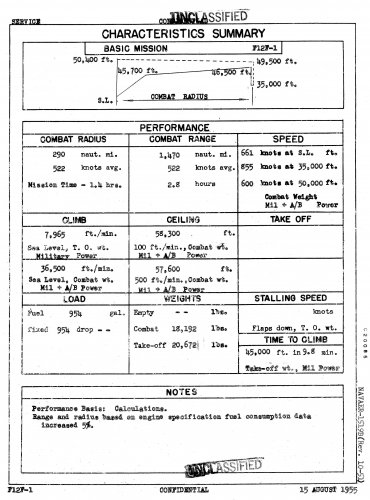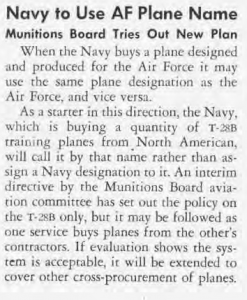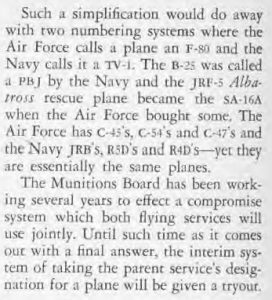- Joined
- 18 March 2008
- Messages
- 3,529
- Reaction score
- 976
This is the product of a bout of insomnia last night… pointless but remotely interesting in a what-if way. What would have happened if the USAF and USN aircraft naming systems were not amalgamated in 1962?
USAF Aircraft Designations
Fighters
McDonnell F-110 Spectre (F-4)
Northrop F-112 Tiger (F-5)
Lockheed YF-113 (YF-12)
McDonnell Douglas F-114 Eagle (F-15)
General Dynamics F-115 Fighting Falcon (F-16)
Northrop YF-116 (YF-17)
Northrop F-117 Tigershark (F-20)
IAI F-118 Kifir (F-21)
Lockheed Martin F-119 Raptor (F-22)
Northrop YF-120 (YF-23)
Lockheed Martin F-121 Lightning II (F-35A)
Lockheed F-208 Nighthawk (F-117)
The F-117 code is purely speculative it would have emerged with a completely different cover code thanks to the continuation of the century series fighter codes. This aircraft would have been the 8th in line of the designation system derived for the MiG-21 (aka YF-110) in USAF service. The JSF does not retain its NASA X-35 code in this series because it would have clashed with the P-35 and it would have been grossly out of sync with other fighters.
Bombers
North American Rockwell B-72 Lancer (B-1)
Northrop Grumman B-73 Spirit (B-2)
Attack Aircraft
LTV A-46 Cowboy (A-7)
Northrop YA-47 (YA-9)
Fairchild A-48 Thunderbolt II (A-10)
General Dynamics/McDonnell Douglas A-49 (A-12)
Cowboy is a speculative name for the A-7D based on the F-110A Spectre example of USAF wanting its own but similar, popular name for a saltwater plane.
USN
Fighters
McDonnell F4H Phantom II (F-4)
General Dynamics F3Y (F-111B)
Grumman F13F Tomcat (F-14)
McDonnell Douglas F5H Wraith (F-18)
Northrop F3T (F-5E)
Lockheed Martin F2V (F-35C)
Attack Aircraft
Grumman A2F Intruder (A-6)
Vought A3U Corsair II (A-7)
General Dynamics/McDonnell Douglas AY Avenger II (A-12)
McDonnell Douglas/BAe A2H Harrier (AV-8)
The Wraith name is speculative but follows the McAir tradition. The A-12A may have been coded the A4H as part of GDFW’s giving up of some naming rights in the partnership deal with McAir. The A3H would have been the planned A-18 Hornet.
USAF Aircraft Designations
Fighters
McDonnell F-110 Spectre (F-4)
Northrop F-112 Tiger (F-5)
Lockheed YF-113 (YF-12)
McDonnell Douglas F-114 Eagle (F-15)
General Dynamics F-115 Fighting Falcon (F-16)
Northrop YF-116 (YF-17)
Northrop F-117 Tigershark (F-20)
IAI F-118 Kifir (F-21)
Lockheed Martin F-119 Raptor (F-22)
Northrop YF-120 (YF-23)
Lockheed Martin F-121 Lightning II (F-35A)
Lockheed F-208 Nighthawk (F-117)
The F-117 code is purely speculative it would have emerged with a completely different cover code thanks to the continuation of the century series fighter codes. This aircraft would have been the 8th in line of the designation system derived for the MiG-21 (aka YF-110) in USAF service. The JSF does not retain its NASA X-35 code in this series because it would have clashed with the P-35 and it would have been grossly out of sync with other fighters.
Bombers
North American Rockwell B-72 Lancer (B-1)
Northrop Grumman B-73 Spirit (B-2)
Attack Aircraft
LTV A-46 Cowboy (A-7)
Northrop YA-47 (YA-9)
Fairchild A-48 Thunderbolt II (A-10)
General Dynamics/McDonnell Douglas A-49 (A-12)
Cowboy is a speculative name for the A-7D based on the F-110A Spectre example of USAF wanting its own but similar, popular name for a saltwater plane.
USN
Fighters
McDonnell F4H Phantom II (F-4)
General Dynamics F3Y (F-111B)
Grumman F13F Tomcat (F-14)
McDonnell Douglas F5H Wraith (F-18)
Northrop F3T (F-5E)
Lockheed Martin F2V (F-35C)
Attack Aircraft
Grumman A2F Intruder (A-6)
Vought A3U Corsair II (A-7)
General Dynamics/McDonnell Douglas AY Avenger II (A-12)
McDonnell Douglas/BAe A2H Harrier (AV-8)
The Wraith name is speculative but follows the McAir tradition. The A-12A may have been coded the A4H as part of GDFW’s giving up of some naming rights in the partnership deal with McAir. The A3H would have been the planned A-18 Hornet.




